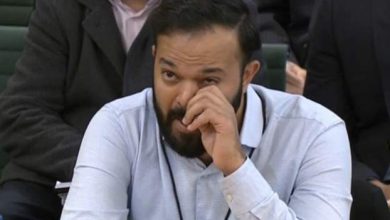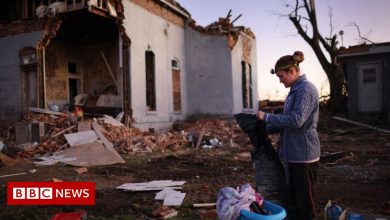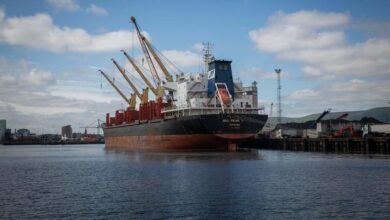What are Storm Shadow missiles and why are they important to Ukraine?
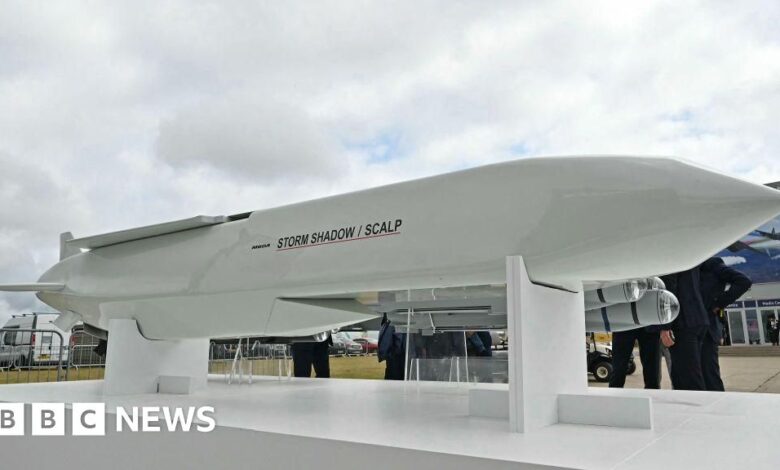
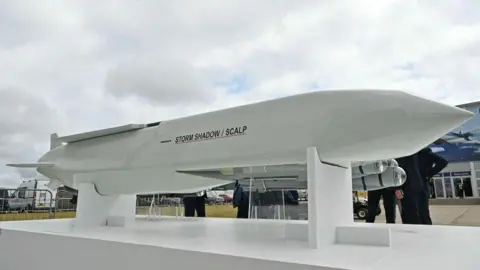 Getty Images
Getty ImagesThere are strong signs that the United States and Britain are set to lift restrictions on Ukraine’s use of long-range missiles against targets inside Russia in the coming days.
Ukraine has a supply of these missiles, but they are restricted to firing them only at targets within its borders. Kyiv has been begging for weeks to have these restrictions lifted so it can fire them at targets inside Russia.
So why is the West so reluctant, and what difference could these missiles make to the war?
What is Storm Shadow?
The Storm Shadow is an Anglo-French cruise missile with a maximum range of about 250km (155 miles). The French call it Scalp.
Britain and France have sent these missiles to Ukraine – but on the condition that Kyiv can only fire them at targets within its borders.
The missile is launched from an aircraft, then flies at near the speed of sound, hugging the terrain before falling and detonating its high-explosive warhead.
The Storm Shadow is considered an ideal weapon for penetrating fortified bunkers and ammunition depots, such as those used by Russia in its war against Ukraine.
But each missile costs nearly $1m (£767,000), so they tend to be launched as part of carefully planned swarms of cheaper drones, sent in advance to confuse and weaken enemy air defences, as Russia did against Ukraine.
They were used to great effect, attacking the Russian Black Sea naval headquarters at Sevastopol and making the entire Crimea unsafe for the Russian navy.
Justin Crump, a military analyst, former British Army officer and managing director of consulting firm Sibylline, said the Storm Shadow was an extremely effective weapon for Ukraine, capable of precision strikes against heavily defended targets in occupied territory.
“It is no surprise that Kyiv has been lobbying for its use inside Russia, particularly against airfields being used to launch glide bomb attacks that have recently hampered Ukraine’s frontline efforts,” he said.
Why does Ukraine want that now?
Ukrainian cities and frontlines are being bombarded by Russia every day.
Many missiles and glide bombs that destroyed military positions, apartment buildings and hospitals were launched by Russian aircraft from far away places in Russian territory.
Kyiv complained that not being allowed to attack the bases that launched these attacks was like forcing them to fight this war with one hand tied behind their back.
At the Globsec security forum I attended in Prague this month, it was even suggested that Russian military air bases were better protected than Ukrainian civilians from being attacked because of these restrictions.
 Getty Images
Getty ImagesUkraine has its own innovative and effective long-range drone program.
Sometimes these drone attacks take the Russians by surprise and reach hundreds of kilometers inside Russia.
But they could only carry a small payload and most were detected and intercepted.
Kyiv argues that to repel Russian air strikes, it needs long-range missiles, including the Storm Shadow and systems similar to the US ATACM, which has an even greater range of 300km.
Why is the West hesitant?
In short: escalation.
Washington fears that while President Vladimir Putin’s red lines have so far been rhetorical, allowing Ukraine to strike targets deep inside Russia with Western-supplied missiles could prompt him to retaliate.
The White House fears that hardliners in the Kremlin might insist on retaliating by attacking missile transit points en route to Ukraine, such as air bases in Poland.
 United States Environmental Protection Agency
United States Environmental Protection AgencyIf that happens, NATO’s Article 5 could be invoked, meaning the alliance would be at war with Russia.
Since Russia’s full-scale invasion of Ukraine on February 24, 2022, the White House’s goal has been to support Kyiv as much as possible without being drawn into a direct conflict with Moscow, which risks leading to the unthinkable: a catastrophic nuclear war.
However, it has allowed Ukraine to use Western-supplied missiles against targets in Crimea and four partially occupied regions that Russia illegally annexed in 2022. Although Moscow considers these regions part of its territory, these claims are not recognized by the United States or internationally.
What difference can Storm Shadow make?
Some, but it may be a case of too little too late. Kyiv has been asking for the use of long-range Western missiles inside Russia for so long that Moscow has taken precautions in case the restrictions are lifted.
The country has moved its bombers, missiles and some of the infrastructure that supports them further away, away from the border with Ukraine and beyond the range of the Storm Shadow.
However, Sibylline’s Justin Crump said while Russia’s air defenses have evolved to counter the threat from Storm Shadow within Ukraine, the task would be much more difficult given the extent of Moscow’s territory that could now be attacked.
“This would make it more difficult to provide military logistics, command and control, and close air support, and even if Russian aircraft were to withdraw further from the Ukrainian border to avoid the missile threat, they would still incur additional time and cost for each sortie to the front line.”
Matthew Savill, director of military science at the Rusi think tank, believes that lifting the restrictions would bring two main benefits to Ukraine.
First, it can “unlock” another system, ATACM.
Second, this would create a dilemma for Russia in terms of where to position these precious air defense systems, which he argued could make it easier for Ukrainian drones to get through.
However, Savill said Storm Shadow is unlikely to turn things around in the end.

